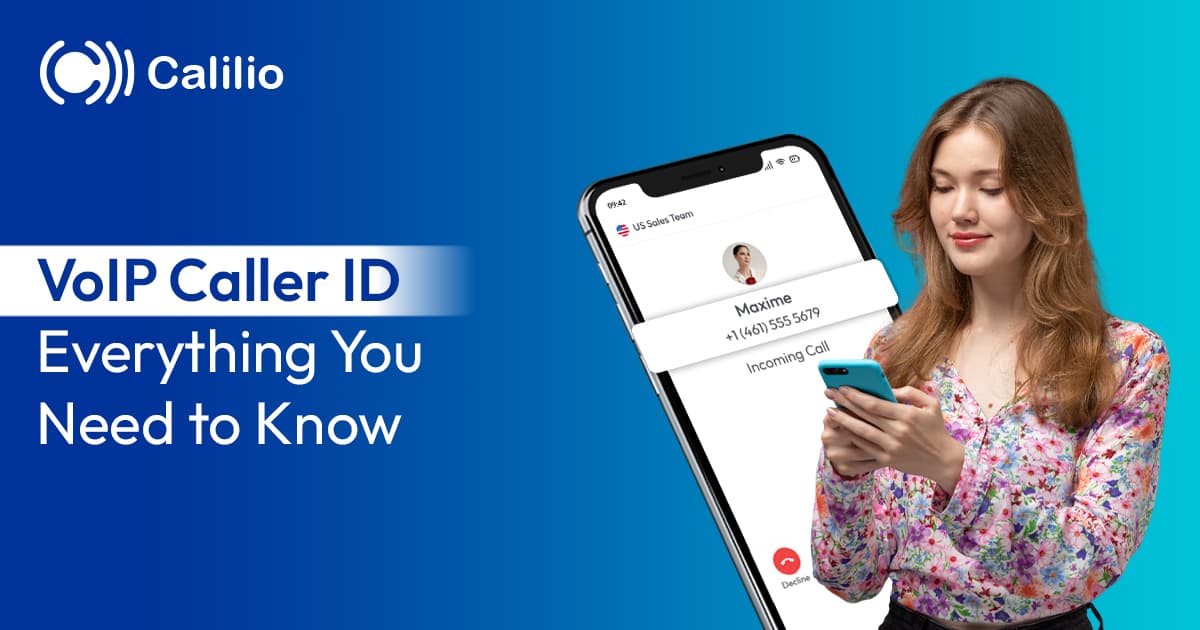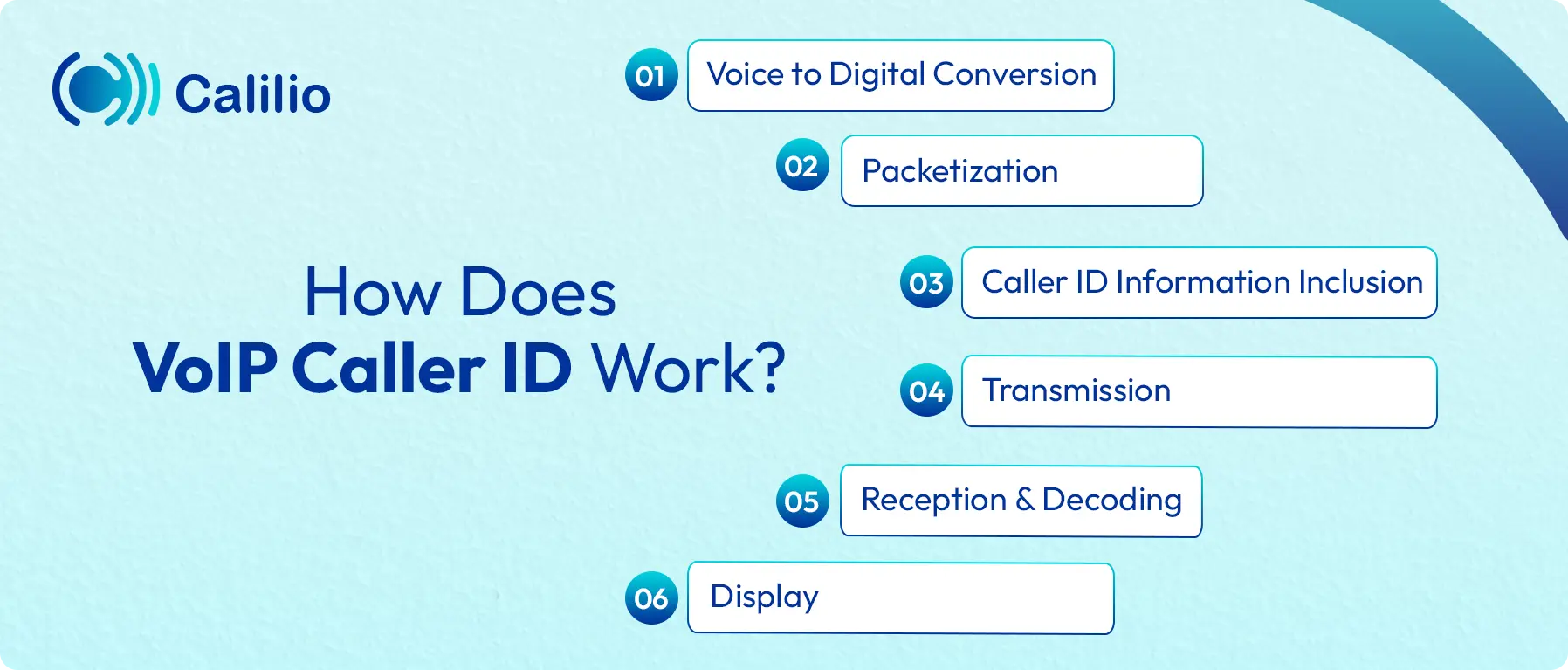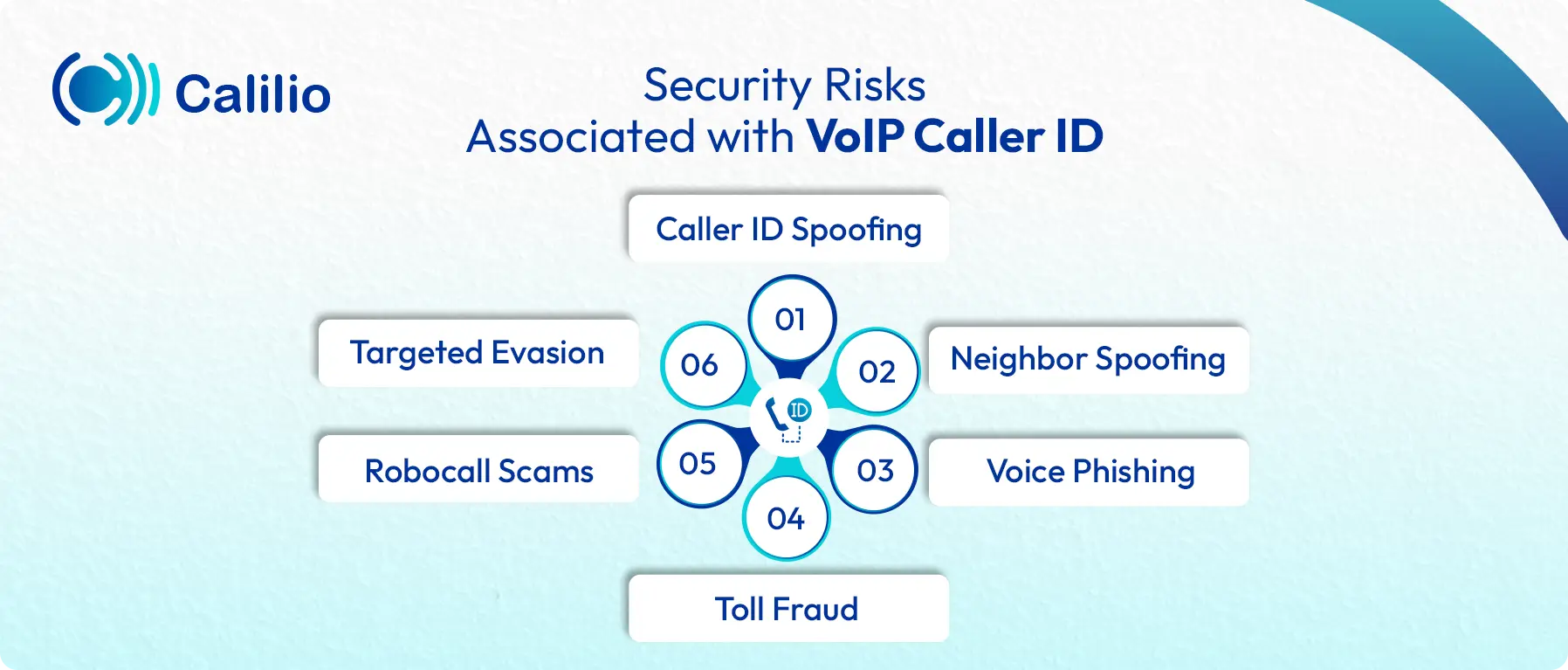What is VoIP Caller ID & How Does It Work?

When your business makes a call, the first thing the recipient sees is your caller ID. If it displays as “Unknown” or “Spam,” your call is likely to be ignored, resulting in missed opportunities, lost sales, and frustrated customers.
A simple fix to this problem is using a VoIP caller ID. This feature allows you to customize your caller ID, ensuring that your business name or a trusted number appears when you call.
In this blog, we’ll explain what VoIP caller ID is, how it works, and how to set it up for your business. You'll also learn its benefits, security risks and best practices to protect your identity.
Key Highlights:
VoIP caller ID lets you display a custom name and number when making calls over the internet, helping businesses appear professional and recognizable.
Compared to traditional systems, VoIP caller ID offers more control, customization, and global flexibility with added features like CRM integration and call analytics.
VoIP caller ID improves call pickup rates, builds trust, enhances your brand visibility, and helps your business appear more professional on every call.
VoIP caller ID also carries risks, including spoofing, phishing, and scam calls.
You can reduce these risks by using a verified provider, turning on encryption, keeping your system updated, and training your team to spot suspicious calls.
What is VoIP Caller ID?
VoIP caller ID is a caller identification feature in Voice over Internet Protocol (VoIP) calls that displays the caller's name and/or phone number to the recipient. Like traditional landline caller ID, it helps the recipient identify who’s calling. However, VoIP adds more flexibility by allowing businesses to customize the displayed information.
Callers can show a business name, department, or local number instead of a random or personal line. This increases the chances of calls being answered and helps build stronger customer relationships through clear and recognizable communication.
How Does VoIP Caller ID Work?
When you place a call over the internet, a VoIP caller ID digitally transmits your name and number along with the voice data. Here’s how it works:

- Voice to Digital Conversion: When you make a call, your voice is converted from sound into digital data, making it possible to send it over the internet.
- Packetization: The digital voice data is then split into small packets, each carrying a part of the conversation and the necessary routing information.
- Caller ID Information Inclusion: Along with the voice data, your phone number and, if available, your name are added to the data packets. This name is often pulled from a CNAM database maintained by your VoIP service provider.
- Transmission: The data packets are sent over the internet using protocols like Session Initiation Protocol (SIP) and Real-time Transport Protocol (RTP), ensuring fast and reliable delivery.
- Reception and Decoding: The recipient’s device receives these packets, reassembles them, and converts the data back into sound so the recipient can hear the call.
- Display: Before the call is answered, the recipient sees the caller ID information, your name and phone number on their screen.
Why Should You Use VoIP Caller ID for Your Business?
VoIP caller ID helps your business look professional, improve call answer rates, and build trust with customers. It shows your business name or number clearly, making people more likely to pick up and engage.
- Professionalism: Displaying your business name or department on the caller ID gives your company a professional image. Customers are more likely to pick up calls from recognized businesses rather than unknown numbers.
- Increases Call Answer Rates: When your business name or a local number appears, customers are more likely to pick up the phone. This increases your chances of connecting with potential clients or addressing customer needs.
- Boosts Customer Trust: By showing a verified business number or name, a VoIP caller ID helps customers feel confident that they are dealing with a legitimate company, rather than getting spam calls.
- Brand Visibility: VoIP caller ID provides a consistent opportunity to display your brand. Every call reinforces your business’s identity, helping customers remember and trust your brand.
- Flexibility: With VoIP caller ID, you have full control over which number or extension shows up on the recipient’s phone. Whether it's your main business line or a specific department, you can ensure the right contact information is displayed.
- Cost-Effective: Many VoIP caller ID features come with your VoIP service, eliminating the need for additional equipment or separate phone lines, which can help reduce costs.
How Do You Set Up VoIP Caller ID?
To set up a VoIP caller ID, you need a virtual number from a VoIP provider that supports caller ID customization. From there, you can add your name or business name to appear on outgoing calls and verify it with a one-time password (OTP) code.
Steps to Set Up VoIP Caller ID on Calilio:
- Sign up for Calilio and purchase a virtual phone number or port your existing number.
- Log in to your Calilio dashboard.
- Go to Settings > Caller ID.
- Click Add a New Caller ID, then enter the name and number you want to display.
- You’ll receive an OTP on the phone number; use it for verification.
- Once verified, your phone number with VoIP caller ID is ready.
Differences Between VoIP Caller ID & Traditional Caller ID
VoIP caller ID offers more control, customization, and advanced features than traditional caller ID. While traditional systems rely on fixed networks with limited flexibility, VoIP provides internet-based delivery with better branding, cost-efficiency, and fraud protection.
Feature | Traditional Caller ID | VoIP Caller ID |
Technology Used | Uses Public Switched Telephone Network (PSTN) through physical copper lines. | Uses VoIP, transmitting calls as digital data online. |
Customization | Very limited; typically shows the phone number with up to a 15-character CNAM name display. | Highly customizable; display a business name, department, or local number easily. |
Caller ID Information | The caller’s number is transmitted; the recipient’s carrier does a CNAM lookup for the name. | VoIP caller name and number are sent digitally, giving more control and flexibility. |
Geographic Flexibility | Tied to a physical location or area code. | Can display any local or international number, regardless of actual location. |
Advanced Features | Basic caller ID display, sometimes with CNAM; no integration with other tools. | Advanced features like CRM integration, analytics, call blocking, and customization. |
Spam & Fraud Protection | Limited; it relies on carrier-level filters, which are often inaccurate. | Stronger protection with tools like STIR/SHAKEN to block spam and spoofed calls. |
Reliability | Mostly reliable; works even during power outages or without internet. | Depends on the internet and power; outages may disrupt service. |
Cost | Higher, especially for long-distance and international calls. | More affordable, particularly for long-distance and international communication. |
Security Risks Associated with VoIP Caller ID
VoIP caller ID can be misused by scammers to hide their real identity and trick people into answering calls or sharing sensitive information. Common risks include spoofed numbers, fake identities, and fraudulent calls that lead to data theft, financial loss, or system abuse.

- Caller ID Spoofing: Scammers pose as authorized parties, like government agencies, banks, or well-established tech companies, to gain victims’ trust and steal sensitive information or money.
- Neighbor Spoofing: Fraudsters manipulate caller IDs to show numbers with the same local area code as the recipient. This makes the call seem familiar and increases the chance that the recipient will answer.
- Voice Phishing: With spoofed caller IDs, attackers call victims and pressure them to give away personal or financial information, such as PINs, passwords, or credit card details.
- Toll Fraud: Hackers exploit VoIP systems and make expensive international or premium-rate calls using fake caller IDs. The charges are billed to the unsuspecting business.
- Robocall Scams: Automated systems use fake numbers to make a high volume of calls. These calls promote scams, direct victims to fraudulent services, or push them to call back premium-rate numbers.
- Targeted Evasion: Scammers constantly rotate spoofed numbers, making it difficult for call-blocking tools or carriers to detect and stop them.
Best Practices to Prevent VoIP Caller ID Risks
To protect your phone number and VoIP caller ID, choose secure providers, use call encryption, and keep your systems updated. Monitor activity regularly, train your team to spot threats, and report spoofing incidents promptly to reduce risk.
- Choose Verified VoIP Providers: Work with providers that implement robust security protocols and caller ID verification to ensure your outbound calls are trusted and harder to spoof.
- Enable Call Encryption: Use encryption to secure your calls and protect caller ID information from being intercepted during transmission.
- Monitor Call Activity: Keep a close eye on your call logs. Detecting unusual call volumes or unknown numbers early can help prevent fraud or misuse.
- Train Employees: Train your staff to identify suspicious calls. They should know not to share sensitive information with unverified callers.
- Keep Software Updated: Regularly update your VoIP systems, apps, and connected devices. Updates often include security patches that close vulnerabilities hackers might target.
- Report Spoofing Cases: If your number is spoofed, immediately report it to your VoIP provider and regulatory authorities. Quick action helps reduce damage and prevents further misuse.
Conclusion
VoIP caller ID does more than display your number. It helps your business appear professional, improves answer rates, and builds customer trust. By showing your brand name or a verified number, you make every call an opportunity to reinforce your company’s identity.
Of course, risks like spoofing and phishing mean caller ID isn’t without challenges. That’s why choosing a reliable provider is essential. With Calilio, you get a customizable VoIP caller ID backed by advanced security features such as spam filtering and caller ID verification. This ensures your calls remain professional, recognizable, and secure.
Your Phone System Just Got Cheaper
Virtual numbers from just $2/month
Call rates starting as low as $0.016/min
The most cost-effective VoIP phone system for businesses
Powered by advanced AI telephony features
Compare low-cost business phone systems
Frequently Asked Questions
What is a VoIP caller ID lookup?
VoIP caller ID lookup is the process of checking a database to find the name linked to a phone number in a VoIP call. If the name is not automatically included in the call data, it helps the receiver see who is calling.
Do all recipients see my caller ID the same way?
How can I test if my VoIP caller ID is working correctly?
Can a VoIP caller ID be faked?

Still have questions?
Can’t find the answer you’re looking for? Please chat with our friendly team.
Stay in the loop
Get the latest call insights, trends, and updates delivered straight to your inbox.
By subscribing, you agree to receive updates from Calilio.
You can unsubscribe anytime.
Phone numbers
Get International Phone Numbers
Singapore
|Australia
|New Zealand